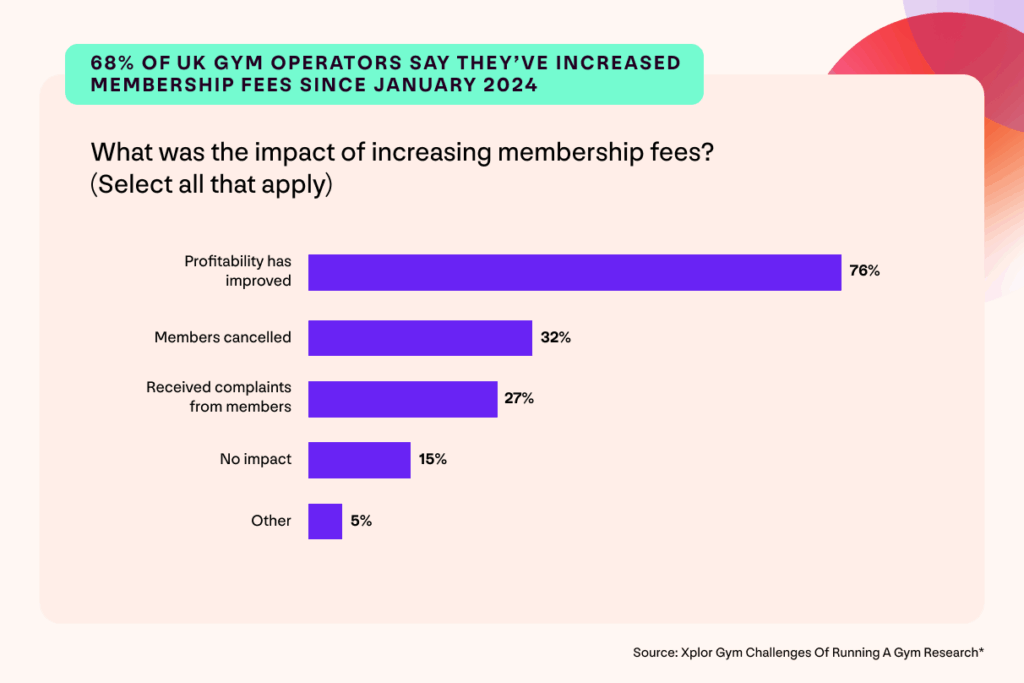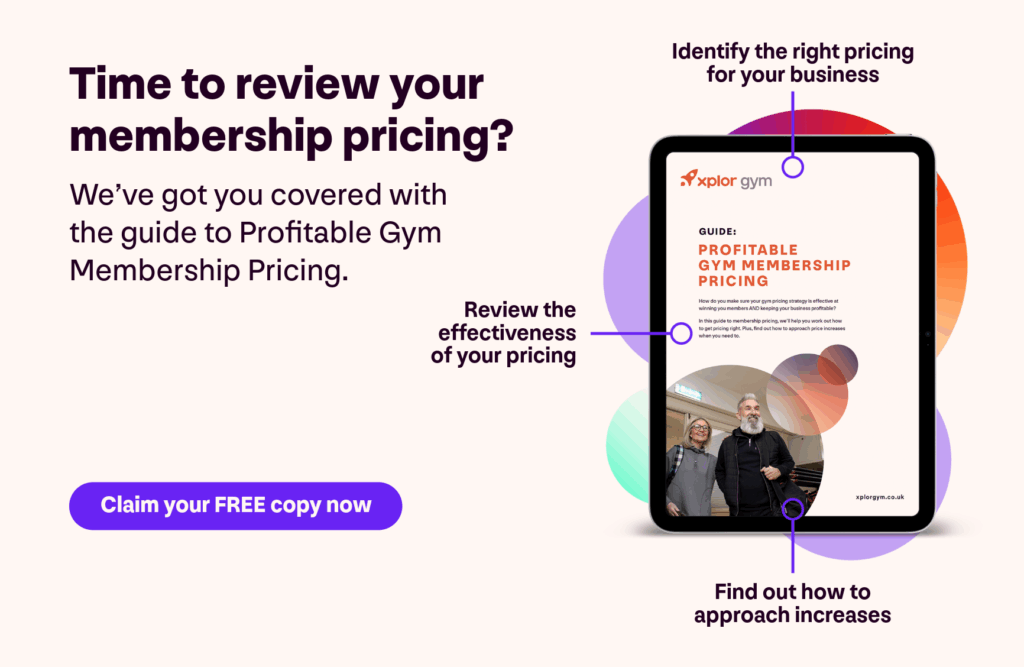Is it possible to increase gym membership prices and keep members? Yes! With a careful approach you can raise your prices with minimal attrition. This is your ultimate guide to managing price increases.
Fear that members will cancel. Fear that you’ll face member complaints. Fear that you’ll disappoint loyal members. Fear holds so many gym operators back from increasing gym membership prices.
Yet often price increases are needed and a very normal occurrence in the course of business. Increases can cover higher operating costs. Fund improvements. And help you improve the profitability of your business.
Nervous about increasing prices? Want to maximise retention and minimise attrition? We’ve got you covered! Read on to learn:
- Why you need to consider price increases
- What raising prices can help you achieve
- How to approach price increases effectively
Let’s get stuck in!
Quick takeaways
Short on time? No sweat! Here are your quick takeaways:
- Operating costs have risen sharply, making membership fee adjustments necessary for most UK gym operators
- Set goals when increasing prices. Do you want to maintain or grow profit margins, boost overall profits, or enhance member satisfaction (or all three)?
- Calculate increases – Analyse the cost of doing business and your profit margins. Review the competitive landscape
- Review your pricing strategy – Introduce or adjust membership tiers to cater to diverse member preferences
- Time it right – Think about the time of year you increase prices to choose a time when members will be most accepting. Give members plenty of notice about the planned change
- Communicate clearly and honestly – Craft confident, concise messages explaining why prices are rising. Emphasise the value members receive. Avoid apologies, focus on benefits, and include FAQs to address likely questions
- Get your team onboard – Brief staff on the what, why, and when of increases. Equip them with talking points and escalation paths. Consistent messaging will keep everyone on the same page
- Be ready to respond to concerns – Prepare for objections. Give members the option to switch to a different package. Consider offering temporary goodwill discounts
- Update prices everywhere – Change fees across your website, contracts, ads, and social media to prevent confusion among new and existing members
- Keep an eye on retention and member LTV – Monitor churn rates closely and calculate lifetime value to assess revenue gains. Small initial dips are normal, but long‑term LTV should rise post‑increase
- Consider regular increases – Establish an annual schedule for modest price rises to set member expectations and avoid abrupt large jumps. Consistency fosters acceptance and simplifies financial planning
The importance of price increases
It’s no secret. The cost of running a fitness business has increased. In fact, in our survey of UK gym operators, 90% said the cost of running fitness facilities has increased over the last year*.
From payroll to utilities, pretty much every category of spend has gone up year-on-year. As operating costs increase, it becomes impossible to run a profitable business. Impossible without increasing membership fees.
Looking beyond fitness, your members are used to seeing price increases.
Food prices. Energy costs. TV and music subscriptions. All have gone up regularly for the past few years. Some service providers even specify when prices will increase and by what percentage within contracts.
So, it should be anticipated that gyms and fitness clubs will put prices up too.
Many operators have increased prices recently, accounting for higher operating costs. According to Leisure DB data, the average gym membership price for private sector gyms in 2025 is £48.45. This is up from £42.99 in 2022.
Yet, our research found that 32% of gym operators surveyed haven’t increased gym membership prices since January 2024*. Keeping prices the same may please some members. But it comes with some risks. For example:
- Members may under value the experience you offer
- Profit margins may erode over time
- It may become tough to fund initiatives that fuel future growth
- You may need to make cuts to reduce the cost of doing business. For example cutting marketing spend, letting staff go, or reducing your offering
Of gym operators who’ve increased prices, over three-quarters increased profitability as result*. This is great news!

The goal(s) of any price increase
It’s clear. Increasing gym membership prices is important and necessary for most operators.
Before you start the process of upping fees, take time to consider what you want to achieve. Typically, there are 3 goals of any price increase – you might look to achieve one or even all three:
- Goal 1: Maintain or increase your profit margins
- Goal 2: Maintain or increase your overall profits
- Goal 3: Maintain or increase member satisfaction

9 tips for successfully increasing gym membership fees
So, how can you increase membership prices while minimising attrition and complaints?
Once you know what you want to achieve by raising fees, these 9 steps will set you up for success.
1. Calculate increases
Work out how much to increase prices by. Often this will be a percentage, although you might choose to make it a specific amount.
To calculate increases, look at:
- Operating costs – evaluate the cost of doing business. Look at every cost including utilities, staffing, and even cleaning supplies
- What your competition charges and the industry standard – how do you measure up? How do your competitors approach pricing?
Make sure you understand your net profit margin. This is the percentage of revenue that’s left after you’ve paid all business costs (including the cost of providing your services and all other expenses).
Gym profitability
Go deeperWant to boost profitability? Check out this comprehensive guide to learn more about profitability and how you can become more profitable.
Get stuck in!Assess the value you offer members. What are the benefits of being a member? How does it feel to be a member? Why do members choose you over your competitors?
Armed with all this information, consider how much you can increase prices by. You might want to get your net profit margin back on track to cover increased operating costs. Or perhaps, you want to increase your net profit margin to reflect the value you deliver to members.
Approach steep hikes with caution
TipIt can be tempting to increase gym membership prices by a significant percentage – say 20%. But gradual increases of a few percent in line with inflation are often better received. Need to make big increases? Consider showing this as a £ amount instead. For example, an increase from £25 to £29.99 a month sounds better than an increase of 20%.
2. Review your pricing strategy
When increasing membership fees, it’s worth re-looking at your gym pricing strategy.

Offer different membership packages? You could retain more members, while increasing prices, by adjusting them:
- Add a new premium tier with access to extra services that members will value. For example, regular biometric assessments, exclusive discounts, health and wellbeing services, or access to personalised nutrition and training plans
- Introduce a basic option that might suit those who just want to use the gym or another specific facility
- Have different payment options with price points reflecting these. Think paid in full annual memberships, flexible pay monthly options, or pay monthly annual contracted memberships
- Consider your pay-as-you-go pricing
When increasing prices, giving members the option of changing their package can reduce attrition. Members should be able to choose to switch to a package that suits their needs. Some may even choose to upgrade to a more attractive package.
A word of caution – changing payment frequency
TipSwitching to billing every 4-weeks can help you achieve 13 payments per year rather than the standard 12. BUT in the UK most consumers are used to paying bills on a specific date each month. And they are paid in a similar way once a month. So, adopting 4-week billing is unlikely to suit members and risks more payment disputes.
3. Time it right
Is there ever an ideal time for a price increase? Honestly, when you’re on the receiving end, probably not! Yet, there are times that may be more acceptable than others.
For example, January and September when demand is higher and you’re entering the new year/new school year. Or at the start of the financial year in April are times when change is more openly received.
Beyond when the price increase happens, it’s essential to give members plenty of notice. If you’re collecting payments via Direct Debit, the minimum notice period before increasing prices is 10 working days.
Ideally, you’ll communicate the increase to members at least a month ahead of time or even longer. Add a follow up communication in a couple of weeks before the increase. Both reminding members of the increase and to catch anyone who missed your first message.
Building in extra time gives your members and your team more opportunity to handle any objections. And more opportunity to move members who want to downgrade (or upgrade) to their new package. Positively impacting retention.
4. Communicate the increase clearly and honestly
Now it’s time to let members know about the increase. How you communicate changes will impact how gym membership price increases are received.
Email is the go-to channel for price increase notifications. You could also consider an SMS follow up referring to the email.
Check your membership contracts for any terms specifying how you’ll notify members of price changes.
What should you say in your price increase communications? These tips will help you craft a message that minimises attrition and complaints:
- Be confident – You’ve done your research. You know the value you deliver to members. Be confident when announcing increases which reflect the value and level of service you deliver
- Don’t apologise – You might feel bad increasing gym membership prices. But apologising sends the wrong message to members. You’re raising prices to protect your business and provide a better member experience
- Be honest and explain why fees are increasing – As well as announcing increases well ahead of time, taking an honest approach will help you maintain positive member relationships. Explain why you are raising prices. Most members will understand and respond better to a straightforward announcement
- Be positive and empathetic – Be positive about the change, while maintaining empathy with members about the impact
- Be clear and concise – Keep the language you use professional but easy to understand. Avoid long messages. And make use of bullet points and other formatting to make the message easier to read. You could also add a frequently asked questions (FAQ) section. Cover any questions you expect members will have
- Always highlight the value members get – Above all, never talk about profit. Focus on the benefits members get and improvements you’ve made (or will be making)
- Tell members you value them – thank them for their continued support. This can work well if the message comes from an owner or director
- Aim to over-deliver – If you have time before a price increase (this works well if you routinely increase prices), make sure you and your team go the extra mile to over-deliver and impress members. Members will be more willing to pay more given the value you’ve provided lately
5. Get your team onboard
Members may speak to your team – especially those in member facing roles – about the increases. So, ahead of communicating changes, you need to get your team up to speed.
Make sure your staff are informed about the increases – what, why, and when. Keep it in line with what you’re telling members. And given them any extra resources and escalation routes for complaints.
This will help avoid awkward conversations with members. And make it easy for your team to direct members to help when needed.
Price vs. value: Selling the value of a gym membership
Go deeperAll too often, gyms and fitness clubs become stuck competing on price. Shifting to selling on value can help you charge what you deserve for memberships. Learn more and find out how to take the leap and start charging on value.
Get stuck in!6. Be ready to respond to concerns
On that note, even with the right timing, plenty of notice, and careful wording, you’ll likely have members raise their concerns.
Ahead of sending your gym membership price increase communication, take time to plan for concerns and complaints. For example:
- Make sure you can clearly explain why increases are necessary. All while keeping calm and not becoming defensive
- Know how to use your software to identify member visit habits. So, if a member feels they’re not getting the value they expect for the new price, you can suggest the next best lower-priced package for them
- Have a goodwill offer ready for members who still need the same level of membership, but need time to adjust their budgets to accommodate the new cost. A small amount off for 2-4 months can make all the difference and show how much you value loyal members
- Be prepared to lose some members. Make sure the leaving experience is a positive one, leaving the door open to a future comeback
7. Update prices everywhere
Ready to send your gym membership price increase communication to existing members? You’ll need to update prices across your website and anywhere else prices appear.
This will avoid you having to let new members know prices will be going up. New members are a higher attrition risk, so this step is important to get right.
Your gym management software should make it easy to adjust prices in your online and in-app joining process. Scan through your website to find any prices that are not automatically changed.
Use Google to pick up prices on your website
TipWhere pages show on search engines like Google, it’s easy to run a search and pick up prices that need updating. Do a search like this swapping in your domain and the old price you’re looking for – site:xplorgym.co.uk “25”
Think about other places where prices might appear. For example, social media ads or leaflets. Update these too.
Your software partner should be on hand to help
TipFor existing members, your software partner should be able to handle the tedious task of updating pricing within your CRM.
8. Keep an eye on retention and member lifetime value (LTV)
Throughout make sure you keep a close eye on retention rates. There may be a slight dip when the increase happens, but overall, it should remain steady.
You should also track member lifetime value (LTV). This should increase in the months after a price increase. Member LTV is a metric that shows on average how much financial benefit a member brings you throughout their time with you.
How to calculate member lifetime value
To calculate LTV, you need to first work out:
- Average revenue per member per month
- Average member lifespan (how many months are paid for on average)
- Average acquisition cost (e.g. marketing, sales, onboarding)
When you have these figures use this formula:
(Average revenue per month x average member lifespan) – acquisition cost
= average member lifetime value
For example, if your average revenue per member per month is £50, your average member lifespan is 15 months, and your average acquisition cost is £30, the calculation would look like this
(£50 x 15) – £30 = £720
9. Consider regular increases
It’s harder to do something when you never do it.
Making increases a regular thing – for example annually at a specific time – can help members come to expect it. And it makes it easier to adjust your prices gradually over time rather than making big hikes.

Alternatives to increasing gym membership prices
Raising prices just not an option? Still need to increase recurring revenue for your business to cover increased operating costs?
Here are a couple of alternatives you could consider:
Introduce an annual fee
Particularly for independent gyms, it can be appropriate to charge an annual fee. Sometimes called a club enhancement fee. This funds improvements and investments into your business to benefit your members.
Often it will be a similar amount to a month’s membership fee and may vary depending on the type of membership held.
This fee should be clearly stated and explained when a membership is sold. It should be included in the membership contract too. Your gym management software should make it easy to collect this fee. Automatically reminding members ahead of the payment being processed.
Add new tiers & bolt-ons
While you may not raise prices for existing membership packages, you could add new packages. Think premium options with added perks. And entry level memberships for those wanting a basic experience.
To create premium options, look to partner with service providers who complement your offering and will appeal to your target audience. Make access to these services available in higher tier options. Examples include:
- Access to health services – from providers like HealthKey who can help your members access services like physio, virtual GP appointments, nutrition advice, blood tests, and more
- Exclusive discounts – from providers like Club Perks who can give your members access to relevant discounts with popular retailers
- DNA testing – from providers like Fitness Genes who can help your members reach their goals with personalised recommendations based on genomic testing
You could also add bolt-ons for specific classes and services like personal training. Promote these to existing members explaining the benefit they’ll get from enhancing their membership.
The wrap up…
Increasing prices is daunting. But, with operating costs rising across the board, it can quickly become impossible to maintain profit margins. And worse, you could end up losing money – putting your business at risk.
There are 3 common goals you can achieve by upping gym membership fees. Maintain or increase your profit margins, overall profits, and/or member satisfaction.
How can you successfully introduce new prices while minimising attrition and complaints?
- Calculate increases
- Review your pricing strategy
- Get the timing right
- Communicate the increase clearly and honestly
- Get your team onboard
- Be ready to respond to concerns
- Update prices everywhere
- Keep an eye on retention and member LTV
- Consider regular increases
There are alternatives to raising prices which will still help you bring in extra recurring revenue. Introduce an annual or club enhancement fee. Add new tiers to your pricing. Or introduce optional bolt-ons.
See what Xplor Gym software can do for your business.
*The Challenges Of Running A Gym Research was conducted by Xplor Gym via an online survey that took place between 28 February and 21 March 2025 with 60 respondents from privately owned gym operators in the UK.
Power up your business & stay in the know

by James Barter Head of Partnerships at Xplor Gym
-
First published: 11 August 2025
Written by: James Barter


